I met Paul in a therapy group for Nam vets. Months passed before he told us the secret he carried for thirty years. After an ambush, enraged,he slit the throats of three local villagers.
“We had ARVN with us,” said Paul. “When the VC opened up,the ARVN ran.”
Twenty-six American’s died that day, including Paul’s best friend Robert. When he saw him dead, Paul climbed on an APC, swung round the fifty cal and shot in the back the fleeing South Vietnamese troops.
“Those motherfucker’s,” he scowled.
Paul showed us a news clipping he kept in his wallet. “That’s him,” he said, unfolding the faded obituary. “My best friend…”
After a time Paul and I buddied up and decided to visit the National Archives 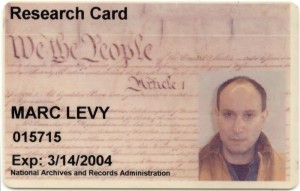 and Records Administration in College Park,Maryland. NARA, as it’s called, resides in a modern six storey building clad in sheet glass and curved panels of white cement. On the ground floor, after stowing our backpacks and cell phones in metal lockers, we were photographed and issued plastic IDs.
and Records Administration in College Park,Maryland. NARA, as it’s called, resides in a modern six storey building clad in sheet glass and curved panels of white cement. On the ground floor, after stowing our backpacks and cell phones in metal lockers, we were photographed and issued plastic IDs.
A polite archive clerk on the second floor helped us submit our requests.
“How long will it take?” I asked.
Five storey’s up, an archivist would methodically roam the stacks in search of war records we hoped he would find.
“Forty-five minutes to an hour,” the clerk replied.
We decided to meet with Richard Boylan,NARA’s S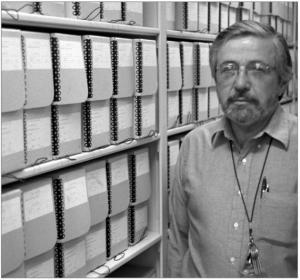 enior Military Archivist. A large tall handsome man, equally patient and pleasant, Boylan spoke with a quiet confidence that belied his experience and expertise. Among many authors, he had assisted BJ Burkett on the research for Stolen Valor. When Boylan offered us a tour of the stacks we gladly accepted. On the way upstairs, I asked him about my battle stars. “We might find something,” he said. NARA’s air controlled fifth floor holds forty thousand archival boxes of military records pertaining to the America war in Vietnam. Army. Navy. Airforce. Marines. From Division to Company level, every surviving document (over the years much has been lost or misplaced or destroyed) is carefully stored here.
enior Military Archivist. A large tall handsome man, equally patient and pleasant, Boylan spoke with a quiet confidence that belied his experience and expertise. Among many authors, he had assisted BJ Burkett on the research for Stolen Valor. When Boylan offered us a tour of the stacks we gladly accepted. On the way upstairs, I asked him about my battle stars. “We might find something,” he said. NARA’s air controlled fifth floor holds forty thousand archival boxes of military records pertaining to the America war in Vietnam. Army. Navy. Airforce. Marines. From Division to Company level, every surviving document (over the years much has been lost or misplaced or destroyed) is carefully stored here.
The enormous fifth floor is divided into twelve rooms,each the size of a small field. We w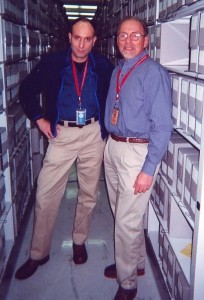 alked past row upon row of densely laden ten foot tall book cases which stood stiffly erect and eerily silent.
alked past row upon row of densely laden ten foot tall book cases which stood stiffly erect and eerily silent.
Richard, softly reading out the posted code letters, suddenly turned right, then walked a few steps into one particular stack.
“First Cavalry Division, First of the Seventh Cavalry,” he said.
“Christ,” I muttered.
Paul shook his head in surprise.
Boylan pointed past one immaculate box,then another,until singling out two white archival boxes labeled ‘Third Brigade. Awards. Letter L.’
I asked if the contents were cataloged by unit.
“No,” he said, “This is everything for 1970.”
In less than a minute Boylan found the original 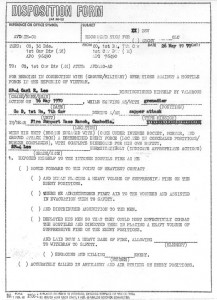 orders for a Bronze Star awarded to Carl Lee. I knew Carl. We had been on the same firebase in Cambodia when it was over run.
orders for a Bronze Star awarded to Carl Lee. I knew Carl. We had been on the same firebase in Cambodia when it was over run.
“Let’s look in the other box,” said Boylan.
He fanned a dozen pages, stopped, looked up. “Here,” he said, holding up three long sheets of yellowing paper. “I think this pertains to you.”
On the second page I spotted my lieutenants firm signature,the blue ink faded but still legible. Beneath it,the Captains close knit imprimatur. I felt chills up my spine.
“I’ve had men leave here, sobbing,” said Boylan. “Then a few months later they’ll write saying thanks, that somehow, it helped them come to terms.”
I don’t know what Paul felt but I could not speak.
Back on the second floor the clerk pointed to six white boxes,their corners tipped with protective metal. “Please sign here,” he said.
After we signed our names, the clerk pointed to the elevators.
A wide open airy space,the third floor research area is preternaturally quiet and calm. An enormous beige carpet seemed to absorb all sound. Twenty or so long wood desks with comfortable black chairs were spaced four or five meters apart. The simple overhead lights were soft and purposeful. Scattered about the sizable room,a half dozen researchers patiently combed through archive records. The scent of old paper hung thick in the air.
and calm. An enormous beige carpet seemed to absorb all sound. Twenty or so long wood desks with comfortable black chairs were spaced four or five meters apart. The simple overhead lights were soft and purposeful. Scattered about the sizable room,a half dozen researchers patiently combed through archive records. The scent of old paper hung thick in the air.
Paul found an empty desk near a panel of windows which overlooked a parcel of vacant land. He smiled at me, opened a box, thumbed through it, found something of interest. I told Paul I’d see him later. He did not look up. At an empty desk by a stair case I sat and read the Unit History for 1/7 Cav 1970. The official summaries of ambushes, firefights, mortar and rocket attacks were cold and brief yet still overwhelmed. As did the long and sometimes cryptic S2 reports for Cambodia (File 1, File 2, File 3, File 4, File 5, File 6, File 7) written by intel officers housed in the rear. The flat and proseless Morning Reports, which simply named the men in my company, caused my head to spin. Too many faces and memories. Too much fear and hope and loss. I closed my eyes to calm down.
My 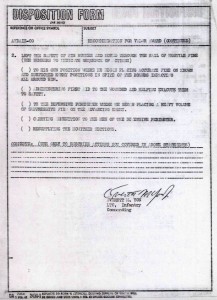 second box contained award citations. How sad to learn that many Bronze Stars were boiler plated. That officers could choose from a list of brief narratives based on MOS:
second box contained award citations. How sad to learn that many Bronze Stars were boiler plated. That officers could choose from a list of brief narratives based on MOS:
Began placing a heavy volume of suppressive fire on enemy positions.
Accurately called in artillery and air strikes on enemy positions.
Administered first aid to the wounded and assisted in evacuation to save them.
So many brave men. So many aging sheets of mimeographed paper, some stamped in thick bold ink “Posthumous.”
A box of Friendly Fire reports contained urgent telex cables and hastily scribbled notes: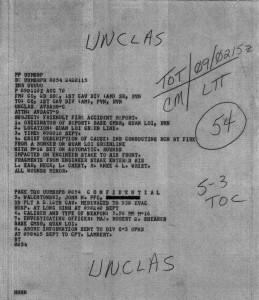
An old timer shot by an FNG behind him.
A suicide found in a bunker with a bottle of liquor,a .45. round to the head.
Men killed or wounded by short fused grenades or short rounds.
I looked at my watch. Three hours had passed. I stood up, stretched, walked over to Paul.
How’s it going,” I asked. When he lowered his hands from his face, his eyes were bleary, as if from crying.
Paul had found a six page report on the battle where Robert had died. He had spent nearly three hours reading the narrative again and again.
“”It’s all here,” he said, his voice quivering. “All here.”
His hands trembled as he set the pages down.
It was winter, cold and snowing, but Paul and I were elsewhere, the heat of battle nipping at our steps we crossed the parking lot back to the car. Driving home, we did not speak for quiet some time.

NARA
I met Paul in a therapy group for Nam vets. Months passed before he told us the secret he carried for thirty years. After an ambush, enraged,he slit the throats of three local villagers.
“We had ARVN with us,” said Paul. “When the VC opened up,the ARVN ran.”
Twenty-six American’s died that day, including Paul’s best friend Robert. When he saw him dead, Paul climbed on an APC, swung round the fifty cal and shot in the back the fleeing South Vietnamese troops.
“Those motherfucker’s,” he scowled.
Paul showed us a news clipping he kept in his wallet. “That’s him,” he said, unfolding the faded obituary. “My best friend…”
After a time Paul and I buddied up and decided to visit the National Archives and Records Administration in College Park,Maryland. NARA, as it’s called, resides in a modern six storey building clad in sheet glass and curved panels of white cement. On the ground floor, after stowing our backpacks and cell phones in metal lockers, we were photographed and issued plastic IDs.
and Records Administration in College Park,Maryland. NARA, as it’s called, resides in a modern six storey building clad in sheet glass and curved panels of white cement. On the ground floor, after stowing our backpacks and cell phones in metal lockers, we were photographed and issued plastic IDs.
A polite archive clerk on the second floor helped us submit our requests.
“How long will it take?” I asked.
Five storey’s up, an archivist would methodically roam the stacks in search of war records we hoped he would find.
“Forty-five minutes to an hour,” the clerk replied.
We decided to meet with Richard Boylan,NARA’s S enior Military Archivist. A large tall handsome man, equally patient and pleasant, Boylan spoke with a quiet confidence that belied his experience and expertise. Among many authors, he had assisted BJ Burkett on the research for Stolen Valor. When Boylan offered us a tour of the stacks we gladly accepted. On the way upstairs, I asked him about my battle stars. “We might find something,” he said. NARA’s air controlled fifth floor holds forty thousand archival boxes of military records pertaining to the America war in Vietnam. Army. Navy. Airforce. Marines. From Division to Company level, every surviving document (over the years much has been lost or misplaced or destroyed) is carefully stored here.
enior Military Archivist. A large tall handsome man, equally patient and pleasant, Boylan spoke with a quiet confidence that belied his experience and expertise. Among many authors, he had assisted BJ Burkett on the research for Stolen Valor. When Boylan offered us a tour of the stacks we gladly accepted. On the way upstairs, I asked him about my battle stars. “We might find something,” he said. NARA’s air controlled fifth floor holds forty thousand archival boxes of military records pertaining to the America war in Vietnam. Army. Navy. Airforce. Marines. From Division to Company level, every surviving document (over the years much has been lost or misplaced or destroyed) is carefully stored here.
The enormous fifth floor is divided into twelve rooms,each the size of a small field. We w alked past row upon row of densely laden ten foot tall book cases which stood stiffly erect and eerily silent.
alked past row upon row of densely laden ten foot tall book cases which stood stiffly erect and eerily silent.
Richard, softly reading out the posted code letters, suddenly turned right, then walked a few steps into one particular stack.
“First Cavalry Division, First of the Seventh Cavalry,” he said.
“Christ,” I muttered.
Paul shook his head in surprise.
Boylan pointed past one immaculate box,then another,until singling out two white archival boxes labeled ‘Third Brigade. Awards. Letter L.’
I asked if the contents were cataloged by unit.
“No,” he said, “This is everything for 1970.”
In less than a minute Boylan found the original orders for a Bronze Star awarded to Carl Lee. I knew Carl. We had been on the same firebase in Cambodia when it was over run.
orders for a Bronze Star awarded to Carl Lee. I knew Carl. We had been on the same firebase in Cambodia when it was over run.
“Let’s look in the other box,” said Boylan.
He fanned a dozen pages, stopped, looked up. “Here,” he said, holding up three long sheets of yellowing paper. “I think this pertains to you.”
On the second page I spotted my lieutenants firm signature,the blue ink faded but still legible. Beneath it,the Captains close knit imprimatur. I felt chills up my spine.
“I’ve had men leave here, sobbing,” said Boylan. “Then a few months later they’ll write saying thanks, that somehow, it helped them come to terms.”
I don’t know what Paul felt but I could not speak.
Back on the second floor the clerk pointed to six white boxes,their corners tipped with protective metal. “Please sign here,” he said.
After we signed our names, the clerk pointed to the elevators.
A wide open airy space,the third floor research area is preternaturally quiet and calm. An enormous beige carpet seemed to absorb all sound. Twenty or so long wood desks with comfortable black chairs were spaced four or five meters apart. The simple overhead lights were soft and purposeful. Scattered about the sizable room,a half dozen researchers patiently combed through archive records. The scent of old paper hung thick in the air.
and calm. An enormous beige carpet seemed to absorb all sound. Twenty or so long wood desks with comfortable black chairs were spaced four or five meters apart. The simple overhead lights were soft and purposeful. Scattered about the sizable room,a half dozen researchers patiently combed through archive records. The scent of old paper hung thick in the air.
Paul found an empty desk near a panel of windows which overlooked a parcel of vacant land. He smiled at me, opened a box, thumbed through it, found something of interest. I told Paul I’d see him later. He did not look up. At an empty desk by a stair case I sat and read the Unit History for 1/7 Cav 1970. The official summaries of ambushes, firefights, mortar and rocket attacks were cold and brief yet still overwhelmed. As did the long and sometimes cryptic S2 reports for Cambodia (File 1, File 2, File 3, File 4, File 5, File 6, File 7) written by intel officers housed in the rear. The flat and proseless Morning Reports, which simply named the men in my company, caused my head to spin. Too many faces and memories. Too much fear and hope and loss. I closed my eyes to calm down.
My second box contained award citations. How sad to learn that many Bronze Stars were boiler plated. That officers could choose from a list of brief narratives based on MOS:
second box contained award citations. How sad to learn that many Bronze Stars were boiler plated. That officers could choose from a list of brief narratives based on MOS:
Began placing a heavy volume of suppressive fire on enemy positions.
Accurately called in artillery and air strikes on enemy positions.
Administered first aid to the wounded and assisted in evacuation to save them.
So many brave men. So many aging sheets of mimeographed paper, some stamped in thick bold ink “Posthumous.”
A box of Friendly Fire reports contained urgent telex cables and hastily scribbled notes:
An old timer shot by an FNG behind him.
A suicide found in a bunker with a bottle of liquor,a .45. round to the head.
Men killed or wounded by short fused grenades or short rounds.
I looked at my watch. Three hours had passed. I stood up, stretched, walked over to Paul.
How’s it going,” I asked. When he lowered his hands from his face, his eyes were bleary, as if from crying.
Paul had found a six page report on the battle where Robert had died. He had spent nearly three hours reading the narrative again and again.
“”It’s all here,” he said, his voice quivering. “All here.”
His hands trembled as he set the pages down.
It was winter, cold and snowing, but Paul and I were elsewhere, the heat of battle nipping at our steps we crossed the parking lot back to the car. Driving home, we did not speak for quiet some time.